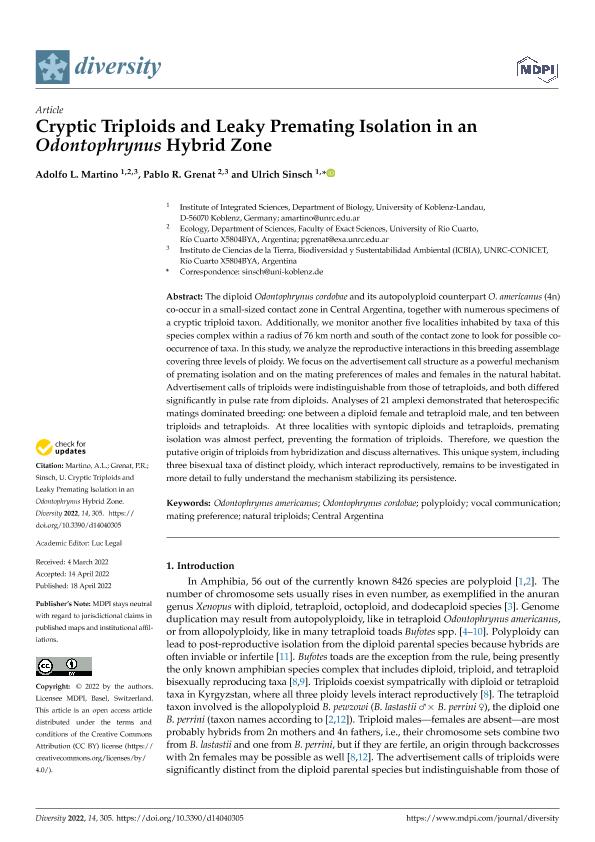Mostrar el registro sencillo del ítem
dc.contributor.author
Martino, Adolfo Ludovico

dc.contributor.author
Grenat, Pablo Raúl

dc.contributor.author
Sinsch, Ulrich
dc.date.available
2023-07-06T18:45:29Z
dc.date.issued
2022-04
dc.identifier.citation
Martino, Adolfo Ludovico; Grenat, Pablo Raúl; Sinsch, Ulrich; Cryptic Triploids and Leaky Premating Isolation in an Odontophrynus Hybrid Zone; Multidisciplinary Digital Publishing Institute; Diversity; 14; 4; 4-2022; 1-13
dc.identifier.issn
1424-2818
dc.identifier.uri
http://hdl.handle.net/11336/202649
dc.description.abstract
The diploid Odontophrynus cordobae and its autopolyploid counterpart O. americanus (4n) co-occur in a small-sized contact zone in Central Argentina, together with numerous specimens of a cryptic triploid taxon. Additionally, we monitor another five localities inhabited by taxa of this species complex within a radius of 76 km north and south of the contact zone to look for possible co-occurrence of taxa. In this study, we analyze the reproductive interactions in this breeding assemblage covering three levels of ploidy. We focus on the advertisement call structure as a powerful mechanism of premating isolation and on the mating preferences of males and females in the natural habitat. Advertisement calls of triploids were indistinguishable from those of tetraploids, and both differed significantly in pulse rate from diploids. Analyses of 21 amplexi demonstrated that heterospecific matings dominated breeding: one between a diploid female and tetraploid male, and ten between triploids and tetraploids. At three localities with syntopic diploids and tetraploids, premating isolation was almost perfect, preventing the formation of triploids. Therefore, we question the putative origin of triploids from hybridization and discuss alternatives. This unique system, including three bisexual taxa of distinct ploidy, which interact reproductively, remains to be investigated in more detail to fully understand the mechanism stabilizing its persistence.
dc.format
application/pdf
dc.language.iso
eng
dc.publisher
Multidisciplinary Digital Publishing Institute
dc.rights
info:eu-repo/semantics/openAccess
dc.rights.uri
https://creativecommons.org/licenses/by/2.5/ar/
dc.subject
ODONTOPHRYNUS AMERICANUS
dc.subject
ODONTOPHRYNUS CORDOBAE
dc.subject
POLYPLOIDY
dc.subject
VOCAL COMMUNICATION
dc.subject
MATING PREFERENCE
dc.subject
NATURAL TRIPLOIDS
dc.subject
CENTRAL ARGENTINA
dc.subject.classification
Zoología, Ornitología, Entomología, Etología

dc.subject.classification
Ciencias Biológicas

dc.subject.classification
CIENCIAS NATURALES Y EXACTAS

dc.title
Cryptic Triploids and Leaky Premating Isolation in an Odontophrynus Hybrid Zone
dc.type
info:eu-repo/semantics/article
dc.type
info:ar-repo/semantics/artículo
dc.type
info:eu-repo/semantics/publishedVersion
dc.date.updated
2023-07-05T12:23:35Z
dc.journal.volume
14
dc.journal.number
4
dc.journal.pagination
1-13
dc.journal.pais
Suiza

dc.journal.ciudad
Basilea
dc.description.fil
Fil: Martino, Adolfo Ludovico. Universidad Nacional de Rio Cuarto. Facultad de Cs.exactas Fisicoquimicas y Naturales. Instituto de Ciencias de la Tierra, Biodiversidad y Ambiente. - Consejo Nacional de Investigaciones Cientificas y Tecnicas. Centro Cientifico Tecnologico Conicet - Cordoba. Instituto de Ciencias de la Tierra, Biodiversidad y Ambiente.; Argentina. Universitat Koblenz; Alemania
dc.description.fil
Fil: Grenat, Pablo Raúl. Universidad Nacional de Rio Cuarto. Facultad de Cs.exactas Fisicoquimicas y Naturales. Instituto de Ciencias de la Tierra, Biodiversidad y Ambiente. - Consejo Nacional de Investigaciones Cientificas y Tecnicas. Centro Cientifico Tecnologico Conicet - Cordoba. Instituto de Ciencias de la Tierra, Biodiversidad y Ambiente.; Argentina
dc.description.fil
Fil: Sinsch, Ulrich. Universitat Koblenz; Alemania
dc.journal.title
Diversity
dc.relation.alternativeid
info:eu-repo/semantics/altIdentifier/url/https://www.mdpi.com/1424-2818/14/4/305
dc.relation.alternativeid
info:eu-repo/semantics/altIdentifier/doi/https://doi.org/10.3390/d14040305
Archivos asociados
